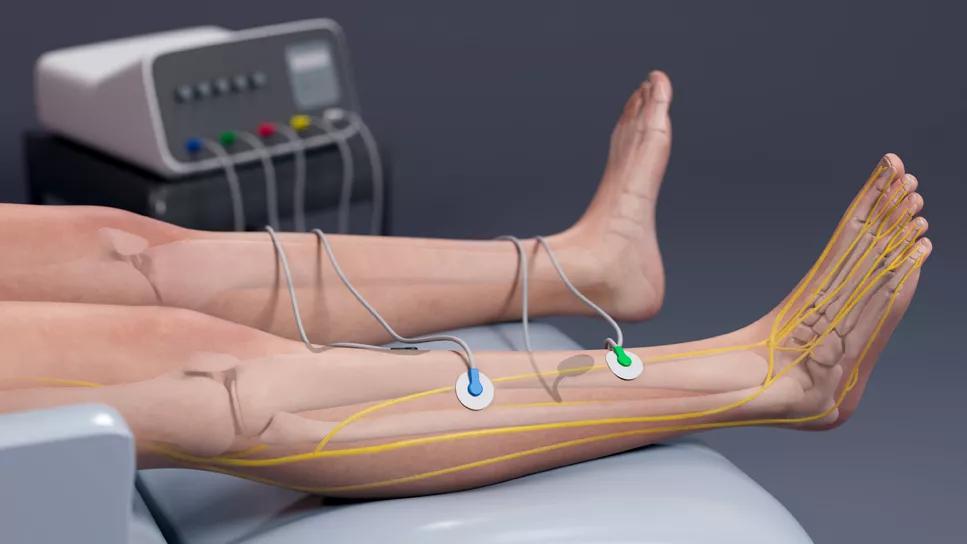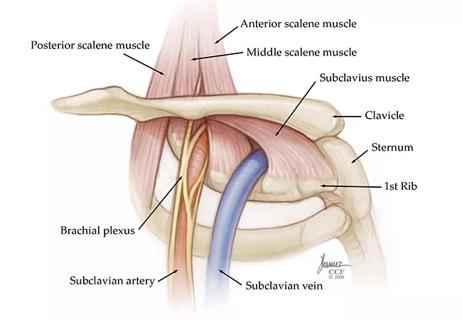Novel therapy “retrains” the brain to disrupt pain signals

Peripheral neuropathy is a common side effect of chemotherapy and radiation, leaving patients with pain, a stabbing or burning sensation and/or numbness in their hands and feet. Pain medications often don’t provide total relief. Scrambler Therapy® is a novel approach to break the cycle of pain without using medications.
Advertisement
Cleveland Clinic is a non-profit academic medical center. Advertising on our site helps support our mission. We do not endorse non-Cleveland Clinic products or services. Policy
Chemotherapy and radiation therapy can cause nerve cells in the body to become damaged, resulting in wrong signals being sent to pain centers in the brain. This causes neuropathic pain. Scrambler Technology is an FDA-approved device that uses electro-analgesia therapy for the noninvasive treatment of chronic neuropathic symptoms, such as pain, tingling, numbness and cold/warm sensation.
"For patients experiencing chronic pain, there is a painful stimulus that is a constant occurrence that gets disassociated from the actual cause of the pain,” explains Chirag Patel, MD, a palliative medicine specialist with Cleveland Clinic Cancer Institute. “The nerve fibers that are transmitting pain signals get in the habit of doing so. Usually there’s some damage that’s caused the pain and over time, the nerve fibers essentially get hardwired to transmit pain signals. So even when the damage is not an actively occurring process anymore, pain signals are still being sent to the brain.”
The Scrambler device disrupts this pain cycle. Using electrodes similar to the ones used for EKG that are carefully placed near the area(s) of pain, the device produces small electrical currents. The currents activate C fibers, producing non-pain signals that override native pain-generating signals. Over the course of multiple treatments, the brain becomes accustomed to experiencing the non-pain signals instead of the pain signals.
“The therapy essentially retrains the brain to feel new signals created by the device instead of feeling pain signals,” explains Renato Samala, MD of Cleveland Clinic Cancer Institute’s Palliative and Supportive Care department. “This can really improve a patient’s quality of life."
Advertisement
People sometimes wonder if the device works the same way as a transcutaneous electrical nerve stimulation (TENS) machine, but the mechanism of action is different. TENS units use electric pulses to prevent pain signals from reaching the spinal cord and brain in the moment, but when the treatment ends, the pain returns. Scrambler Technology is designed to offer long-term alleviation of pain.
Though the therapy doesn’t work for everyone, for those that it does, the experience can be life changing. One cancer survivor with neuropathy caused by chemotherapy previously described his pain as feeling like stepping on sharp objects all the time. “We treated him for four sessions with Scrambler Therapy and the pain was totally gone,” says Dr. Samala. “He’s doing well and enjoying outdoor activities again.”
The therapy may be used for patients with longstanding neuropathic pain or other symptoms of chronic neuropathy involving the arms, legs or trunk. Cleveland Clinic Cancer Institute is currently offering the therapy to adult patients with chemotherapy-induced peripheral neuropathy or chronic neuropathy from other causes.
This therapy may be appropriate for patients for whom conventional treatments like gabapentin or pregabalin haven’t helped, or who are seeking an alternative to pain medications. Typically, patients receive the treatment in 30-60-minute sessions daily for two weeks. Many patients report feeling a sensation like vibrating or buzzing during the session but should not feel any discomfort. Patients first undergo an evaluation to see if they would benefit from Scrambler Therapy. “Pain should improve right after treatment for us to know that Scrambler Therapy is right for them,” says Dr. Samala. “If this happens, then the full 10-day treatment course will be offered.”
Advertisement
The treatment cannot be administered while patients are still undergoing chemotherapy with certain drugs or radiation therapy. However, those who have completed their course of chemotherapy or radiation therapy and are experiencing pain or numbness in their extremities may be a candidate.
Contraindications for the therapy include:
Advertisement
Advertisement

Multidisciplinary perspectives on the importance of early referral and more

Findings could help with management of a common, dose-limiting side effect

Pain specialists can play a role in identifying surgical candidates

Spinal cord stimulation can help those who are optimized for success

Large retrospective study suggests DOACs are safe, effective alternative to low-molecular-weight heparin in complex patient population

Care paths and research initiatives aim to answer unmet clinical needs

Study shows high rate of hematologic responses, low rate of disease progression

Bispecific antibody bridging therapy deepens durability of BCMA CAR T-cell therapy without overlapping toxicities in patients with relapsed/refractory multiple myeloma